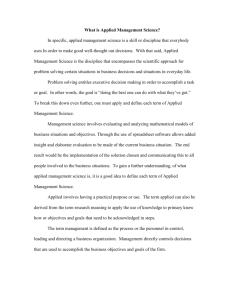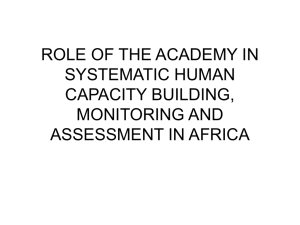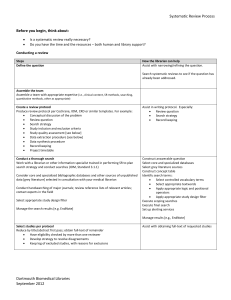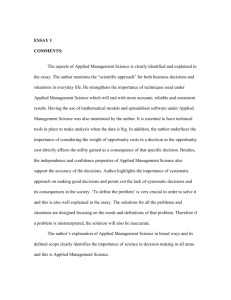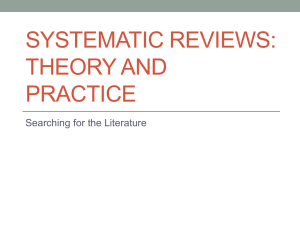SOLVING THE RISKS AND RETURNS PUZZLE
advertisement
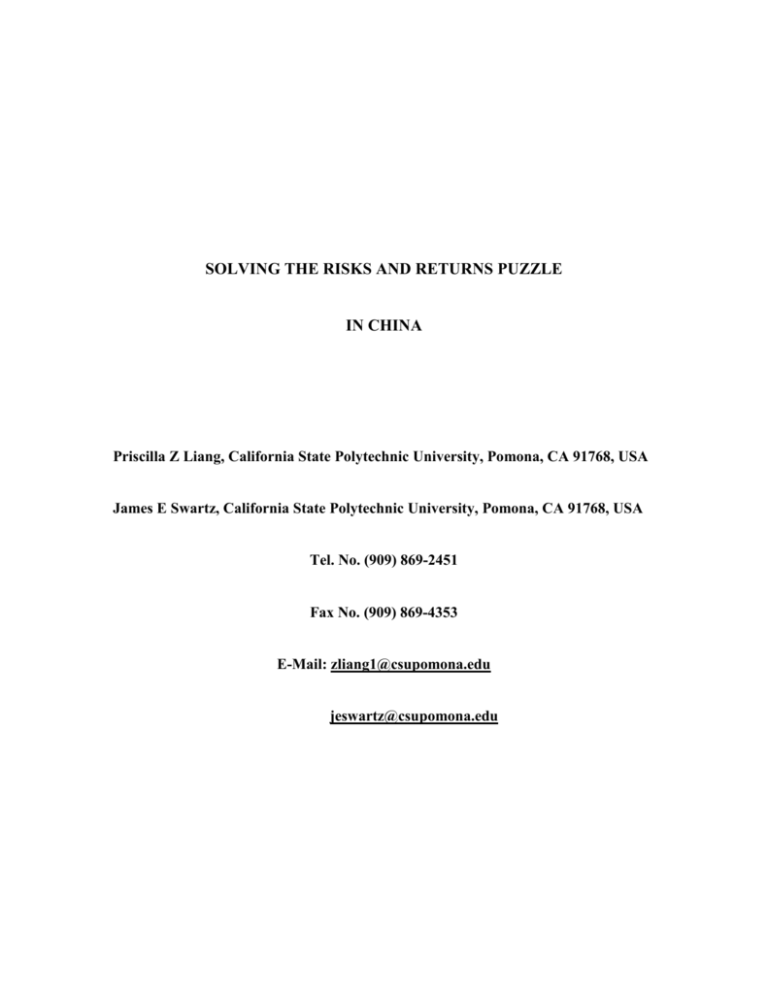
SOLVING THE RISKS AND RETURNS PUZZLE IN CHINA Priscilla Z Liang, California State Polytechnic University, Pomona, CA 91768, USA James E Swartz, California State Polytechnic University, Pomona, CA 91768, USA Tel. No. (909) 869-2451 Fax No. (909) 869-4353 E-Mail: zliang1@csupomona.edu jeswartz@csupomona.edu SOLVING THE RISKS AND RETURNS PUZZLE IN CHINA ABSTRACT The MSCI China index has offered investors below average returns and high volatilities, but the China index has continued to be a global portfolio investor’s favorite. This paper suggests several solutions, both from behavioral and traditional finance perspective, on risks and returns mismatch in China, The study focuses on using the World Capital Asset Pricing Model to decompose total risks of China’s index returns into global systematic risks, regional systematic risks and country specific risks. The study argues that the China Index earns lower returns because its systematic risks are lower. The study finds China’s systematic risks, both global and regional, have been increasing, but more so at the global level. INTRODUCTION In an examination of the capital markets behavior in the United States for the past eighty years, we have learned two important lessons, namely, that higher risks need to be compensated by higher returns, and higher returns must be accompanied by higher risks. In other words, there is a symbiotic, causal relationship between risks and returns. Even though these lessons are mainly drawn from the American capital markets, theoretically, they should apply in international markets as well if global capital markets are efficient. However, risks and returns do not always come in such neatly related pairs if we study an individual country’s returns. Since the opening of Chinese capital markets to the world, the uniqueness of the market structures and patterns of returns have always puzzled academics. Despite heavy government regulation, lower than average returns, higher than average volatilities, and limited information disclosure of companies, China continues to be a global investor’s favorite choice. Has the risk/return relationship been violated? Why do investors favor China? We find that one of the answers lies at the heart of world Capital Asset Pricing Theory. With so many countries that have opened or liberalized their capital markets, investors can form a well-diversified global portfolio with little or no cost. Capital Asset pricing theory tells us that an expected required rate of return of a specific asset is determined by this asset’s systematic risk levels. Countries like China have lower regional and global systematic risks, which provide investors with more opportunity for diversification, leading them to ask for lower returns. Country specific risks are priced, but in a less important degree within a global or regional portfolio because China’s global systematic risks have surpassed country specific risks since China’s entry into the WTO in 2001. LITERATURE REVIEW Historical Perspective Being a relative newcomer to the global stock exchange family, Chinese equity markets are still illiquid and inefficient. The beginning of the Chinese stock exchange starts from the opening of the Shanghai Stock Exchange in 1990 and Shenzhen exchange in 1991. The first batch of carefully selected shares was cross-listed on the Hong Kong exchange in December 1992, and by 1995, Chinese companies had been cross-listed on major stock exchanges such as those in New York, Tokyo, London, Australia, Singapore and Canada. Just as in other emerging equity markets, investors in Chinese stock exchanges face difficulties such as information barriers, different accounting standards and regulation incompetence. Moreover, they are subject to obstacles brought by many unique features in Chinese markets. For example, China has restrictions on investment ownership. Domestic shares are known as A shares and shares for international investors are known as B shares and H shares1. B shares are listed on the major international markets and H shares are listed on the Hong Kong exchange. There are more strict rules on China’s A 1 Another puzzle: Why do domestic shares in China have higher risk premiums than international shares? share markets. Shareholders are separated into state, enterprise and individuals. State shares cannot be sold to individual or enterprise shareholders, and enterprise shares cannot be sold to individual shareholders. These restrictions have caused the small capitalization and thinness of the markets (Wellons, 1997). Not only does the government control how the trading rules are set, the government also determines which stock should be put on global markets. Companies were carefully hand picked by using the “neither bad nor good” in profitability and “neither big nor small” in size rule before being given permission to raise capital in global exchanges. This adds more to the market inefficiency and leads to lower average returns for many of the cross-listed Chinese firms. We consider this as our first explanation to China’s low returns. Literature Review The global equity investment has grown large each year. In 2003, the international markets represented slightly more than half of the world’s investment opportunities, up from about one-third in 19702. The diving forces behind international investments are diversification benefit and higher risk-adjusted returns. However, Harvey and Roper (1999) find that the overall returns of equity investments in Asia are low compared to investments in other markets. Returns in China are even worse. Regardless of the risk and return mismatch in China, research into the risk/return relationship in Chinese equity markets is rare. Campbell Harvey3 has done substantial research in studying global equity risks. His work, such as “A Detailed Chronology of Important Financial, Economic, and Political Events in Emerging Markets”, and “Exploratory Investigation of Country Returns” are well known. Erb, Viskanta and Harvey (1996) have studied the influence of political, economic and financial risk on expected fixed income returns. This is one of a few published studies that address the differences between various sources of systematic risks. Brook’s (2003) study of stock 2 3 Sources: standard & Poor’s; Morgan Stanley. http://www.duke.edu/~charvey/Country_risk/couindex.htm returns in China and found the betas and the correlations of China relative to the world index are both very low in contrast to the developed equity markets. Some studies have looked at the risk characteristics at the Asian regional level. Chen and Wong (2003) suggest that shocks that have most impact on determining Asian equity returns are mostly country specific. Tai (2004) finds that Asian equity markets are more stabilized through the financial liberalization process. The volatility and cost of capital has decreased after the liberalization, which means benefit of diversification in an Asian portfolio has increased. Harvey and Roper (1999) show that Asian stock markets are vulnerable to common industrial based shocks. From the behavioral finance literature, we draw another solution to China’s risks and returns puzzle. Odean (1999) finds that due to attention effect, investors buy stocks that have caught their attention. Thus, a great deal of buying is at the extremes of the market. We suggest therefore that China, one of the last remaining communist empires with consistent super economic growth, is one of the lingering examples of global investors’ extreme purchase. Our remaining study, however, will shift away from the behavioral finance perspective. We attempt to answer the risk/return puzzle from a traditional finance approach by using World Capital Asset Pricing Theory. THERORY AND METHODOLOGY The World Capital Asset Pricing Model Capital Asset Pricing Theory says if an investor holds only one asset, he is exposed to total risks, which are measured by the standard deviation of the asset returns. However, if one forms a well-diversified market portfolio, risk levels of the portfolio decrease. By forming a portfolio, one can diversify away asset specific risks. Only systematic risks or market risks remain. Thus, total risks have two components, market risks and asset specific risks. Markets risks are risks that have impact on most of the assets. War and recessions are typical examples of market risks. Asset specific risks are risk factors that affect a limited number of assets, such as part shortages and incompetent management of a company. Since asset specific risks can be diversified away within a well-diversified portfolio and investors are able to form such portfolios with little or no cost, asset specific risks should not be compensated. Based on the Capital Asset Pricing Model (CAPM), an asset’s expected returns are priced by its systematic risk level. Systematic risks are measured by beta. They measure an asset’s contributions of systematic risks to a portfolio if this asset is added. If an asset has low systematic risks, it is less sensitive to a certain market shock, which contributes less risk to a portfolio. In a sense, even if an asset has a high standard deviation, investors should ask for lower rate of returns if the beta of this asset is low. In a global concept, one can rewrite an asset’s risk components by using a global CAPM. Thus, Total risks (of a country index) = Systematic risks + Asset (Country) specific risks Even though CAPM remains as one of the most useful tools in analyzing relationships between risks and returns, when Fama and French (1992) found that the ability of beta to explain the differences in asset returns goes away when price-to-book ratio and market capitalization factors are introduced, CAPM has been under severe attack. Many say Beta is dead. They claim CAPM failed not only to stand up to empirical testing, but also to explain returns of international assets. It is true that one should be cautious when applying CAPM to international settings, especially to emerging stock markets. Studies by Bekaert et al. (1997, 1998) suggest that the pattern of returns in emerging markets is much different from that in developed markets. In particular, the evidence shows that emerging market returns are generally non-normally distributed, and that these deviations from normality appear to be time varying. The presence of substantial skewness and kurtosis in returns suggests that simple two-parameter asset pricing models where returns are a linear function of systematic (beta) risks will give inaccurate predictions of expected returns. This study, however, argues that CAPM is still a simple yet powerful asset pricing tool. Since most emerging markets data are not normally distributed with constant means, variance and covariance, then mean, variance and covariance should be non-constant. In other word, beta should be time-varying (Ng 2002) because factors affecting beta are time varying. For example, leverage of the firm (debt-equity ratio) depends on the changes in interest rates and market prices of the company’s stocks. It is known that price-book ratio is highly correlated with debt-equity ratio. If one put beta in a dynamic aspect, Fama and French’s finding can be well explained. Most recent studies use multivariate GARCH techniques to capture beta’s time-varying features. The purpose of this paper, however, is not to predict asset returns, but to separate and measure different market (systematic) risks. If systematic risks being measured have significant explanatory power in determining an asset return, a linear function is adequate for the study. DATA We use the MSCI All County World Index (MSCI ACWI) as a proxy of a global index, and the MSCI All County Asia Index (MSCI AC ASIA) as a proxy of an Asia index, and MSCI China Index as a proxy of China return. The China index serves as a component in both the Asia and World indices. Since the China index is available only from December 1992, data are expressed in U.S. dollars with December 1992 as 100. The data range from December 1992 to January 2005, for a total of 145 months. Logarithmic returns are calculated as Ri ,t log( Ri ,t / Ri ,t 1 ) (1) Analyzing the three indices we can see that China Index offers the lowest average return (negative) but with high volatility. The standard deviation of the China index is approximately twice of that of the Asian index, and 2.7 times of that of the world index (See Table 1 and Figure 1). Table 1 Summary Statistics China Asia World Mean -0.004193 0.000407 0.002424 Median -0.006032 0.000596 0.005228 Maximum 0.165828 0.070985 0.037355 Minimum -0.140692 -0.065188 -0.066261 Std. Dev. 0.048634 0.024745 0.017909 145 145 145 Observations Sample: 1993:01 2005:01 Figure 1 Comparison of MSCI World, Asia, USA and China Index Returns World Comparison of MSCI World, Asia, USA and China Index Returns Asia USA 400 China 350 300 Returns 250 200 150 100 50 0 Dec-87 Dec-88 Dec-89 Dec-90 Dec-91 Dec-92 Dec-93 Dec-94 Dec-95 Dec-96 Time Dec-97 Dec-98 Dec-99 Dec-00 Dec-01 Dec-02 Dec-03 Dec-04 Comparing China Index returns with those of countries with similar characteristics, such as India and Pakistan, who are also relatively new members in the MSCI family; and Hong Kong, Singapore and Taiwan, who are geographically and economically close to China, we find China has the worst performance as well (See Figure 2 and 3). Figure 2: Comparison of MSCI China, India and Pakistan Index Returns China Comparison of MSCI China, India and Pakistan Index Returns India 250 Pakistan 200 Returns 150 100 50 0 Dec-92 Dec-93 Dec-94 Dec-95 Dec-96 Dec-97 Dec-98 Time Dec-99 Dec-00 Dec-01 Dec-02 Dec-03 Dec-04 Figure 3: Comparison of MSCI China, Hong Kong, Singapore and Taiwan Index Returns China Comparison of China, Hong Kong, Singapore and Taiwan Index Returns Hong Kong Singapore 600 Taiw an 500 Returns 400 300 200 100 0 Dec-87 Dec-88 Dec-89 Dec-90 Dec-91 Dec-92 Dec-93 Dec-94 Dec-95 Dec-96 Dec-97 Dec-98 Dec-99 Dec-00 Dec-01 Dec-02 Dec-03 Dec-04 Time Methodology This study modifies Akodogan’s (1996) risk decomposition model to solve risk/return puzzle in China. Applying World CAPM, Akodogan decomposes total risks of a country index return into world systematic risks and country specific risks. Akodogan’s method is as follows: Ri i i Rg i (2) where Ri represents a specific country’s return, and Rg represents a benchmark world index return. Assuming variance of both sides, var( Ri ) i var( Rg ) var( i ) 2 (3) Then dividing both sides by var( Ri ) , one gets pi qi 1 (4) Where pi i2 var( Rg ) / var( Ri ) , and qi var( i ) / var( Ri ) , measure ith the country’s contribution to worldwide systematic and unsystematic risks respectively. However, in his original work, Akodogan defines p i as a measurement of a specific country’s global integration. This study improves Akdogan’s approach in three ways. First, it adds a measurement of regional systematic risks into Akodogan’s model; second, it tries to capture the timevarying characteristics of the measurements; and third, it defines Pi only as a measure of systematic risks instead of a measure of integration level, for we argue that degrees of integration are not equivalent to levels of systematic risks.4 Our model is as follows; First, we regress the regional index on the world index to obtain the residual. Ra a a Rg a Ra represents returns of the Asian Index. (5) Rg represents returns of the World index. a captures the changes in the Asian portfolio that cannot be explained by the world index. Thus a is orthogonal to Rg . Then we measure China’s return using two explanatory variables, the world index, and the regional shocks of Asia, which is measured by a . Rc c ca a cg Rg c Where Rc represent MSCI China index returns. (6) Next we take the variances of equation (6), and divide both sides by the variances of China’s return, we get 1 ca2 var( a ) / var( Rc ) + cg2 var( Rg ) / var( Rc ) + var( c ) / var( Rc ) (7) Thus the total risks of China’s returns can be separated into three parts, regional systematic risks, global systematic risks and China’s country specific risks, which are the unsystematic part. Let’s define pc ca2 var( a ) / var( Rc ) (8) qc cg2 var( Rg ) / var( Rc ) (9) rc var( c ) / var( Rc ) (10) Where pc measures how much variations of a China index can be explained by Asian regional systematic risks. qc measures the degrees of variations of a China index that are affected by world systematic risks. rc measures the country specific risks, the unsystematic risks which can be diversified away if investors form a well-diversified international portfolio. We use the concept of World Capital Asset Pricing Model and assume investors’ expected returns of a particular country index are based on its systematic risk levels, which are measured by the p and q in the above equations, instead of on the total risk levels, which are measured by the standard deviation of that index. To capture the time-varying characteristic of these risk measures, 12 months moving averages are calculated, starting from January 1993, with intervals of one month. Measurements are also calculated over different time intervals to check the robustness of the test. 4 This issue will be discussed in detail in ““Global equity markets integration, interdependence and FINDINGS From a simple correlation analysis (See Table 2), we see that the China index returns are, on average, more correlated with the MSCI World index than with the MSCI Asia index during the past 12 years. Table 2 Correlations China Asia China 1 Asia 0.307 1 World 0.400 0.738 World 1 Table 3 shows the developmental path of China’s global and regional systematic risks. Figure 4 shows the same trends, but includes the country specific risks. Table 3 Average Global vs. Regional Systematic Risks of China Index Returns (1993-2004) Year 1993 1994 1995 1996 1997 1998 1999 2000 2001 2002 2003 2004 Global Systematic Risks 0.001 0.085 0.213 0.023 0.025 0.170 0.256 0.048 0.512 0.435 0.347 0.556 efficiency: a clarification", forthcoming Regional Systematic Risks 0.435 0.290 0.151 0.255 0.050 0.003 0.069 0.072 0.006 0.101 0.287 0.100 Comparison of China’s Global Systematic Risks, Regional Systematic Figure 4 Risks and Country Specific Risks Country Risks Risk Decompositions of China Index World Systematic Risks Asian Systematic Risks 1 0.9 0.8 0.7 0.6 0.5 0.4 0.3 0.2 0.1 0 1993 1994 1995 1996 1997 1998 1999 2000 2001 2002 2003 2004 Even though country specific risks play the dominant role in determining Chinese index returns, we observe that China’s global systematic risks have gradually increased over the past decade, and the intensity has picked up dramatically since 2001 when China officially joined the WTO. China’s regional systematic risks hit its lowest point after the Asian Financial Crises due to tight capital controls. The level has risen since WTO entry, but to a lesser degree than its world systematic risks. The impact of country specific risk on the variation of the China index return reached the highest point during the Asian crises period. To further analyze the developmental trend of China’s systematic risks, we separate them at two points, the Asian financial crisis and China’s WTO entry date. Figure 4 shows that before 1997, China’s country specific risks played the most important role in determining its stock return, Asian systematic risks ranked second, and the world systematic risks the least. After the Asian financial crises, world systematic risks outranked Asian systematic risks. After 2003, China’s world systematic risk levels have surpassed both regional systematic risks and country specific risks, and have become the dominant factor in determining China’s return. We conclude that China was more sensitive to a regional common shock before the crises, but more so to a global common shock after the crises. Since China joined the WTO, its responsiveness to a world shock increased dramatically. It is fair to say that investors expected returns priced mostly on China’s systematic risks instead of its country specific risks. Table 4 illustrates the same analysis. Table 4 Developmental Trends of China’s Systematic Risks Systematic Before Asian After Asian Risks Financial Crises Financial Before Join WTO After Join WTO Crises (Asian Crises: July 1997) (Official Date of entry: December 2001) Regional 0.17 0.10 0.11 0.19 Global 0.08 0.35 0.19 0.45 In order to compare levels of systematic risks of China with those of other Asian countries, similar analyses have been performed on the rest of eleven Asian countries that are included in the MSCI AC ASIA index. Compared to other Asian countries, China’s global and regional systematic risk levels are lower than average. Its average global systematic risks rank seven out of twelve candidates, and average regional systematic risks rank number four of twelve (See Table 5 and 6). Table 5 Global Systematic Risks of Country Index Returns in Asia (Periods: January 1993 – January 2005) Rank 1 2 3 4 5 6 7 8 9 10 11 12 Table 6 Country Global Systematic Risks Japan 0.433 Hong Kong 0.425 Singapore 0.424 Korea 0.338 Thailand 0.328 Taiwan 0.248 China 0.242 Indonesia 0.232 Philliphines 0.230 Malaysia 0.228 India 0.162 Pakistan 0.088 Regional Systematic Risks of Country Index Returns in Asia (Periods: January 1993 – January 2005) Rank 1 2 3 4 5 6 7 8 9 10 11 12 Country Regional Systematic Risks Japan 0.513 Korea 0.143 India 0.128 China 0.128 Indonesia 0.123 Thailand 0.123 Hong Kong 0.116 Taiwan 0.087 Pakistan 0.084 Philliphines 0.066 Malaysia 0.063 Singapore 0.063 Why invest in China? Using the risk decomposition method, this study finds another explanation for the risk/return puzzle in China. Investors favor China because China has lower systematic risks than those of other Asian countries. China’s global systematic risks rank only number seven among nine emerging Asian nations, which means China’s index contributes less risk when it is added to a global portfolio, providing investors a great opportunity for risk diversification. Based on World CAPM, in an efficient market, investors ask for a lower expected rate of returns for an asset with lower systematic risks, regardless the volatility of that asset. This is the case of China. But one might argue that the Chinese financial market, and even the Asian financial market, is not efficient. Country specific risks should be priced and given large weight. We agree with this opinion. However, we want to point out that China’s global systematic risks alone have been higher than its country specific risks since 2001. So China’s systematic risks, the combined global and regional ones, are definitely becoming the dominant source in determining China’s returns. Thus, we suggest that investors might consider the diversification benefit from investing in China more since its systematic risks are higher than its country specific risks, but still lower than those of most other Asian countries. Furthermore, total risk levels have been decreasing in China. One might recall that valuation of a stock is a process of discounting expected future cash flows. If expected future cash flows increase or discount rates used to measure risk levels decrease, the value of stock will rise. We can see both of these factors in China index returns. CONCLUSIONS So why would one choose to invest in China? Our study shows one of the explanations is China’s lower levels of global and regional systematic risks. When an individual country has lower levels of regional or global systematic risks, its index contributes less risk to a global or regional portfolio. Thus investors will ask for lower returns because their expected returns are determined by the systematic risk levels. However, we want to address that we didn’t solve the China puzzle completely. One can raise questions such as what if country-specific risks cannot be diversified away, and risks such as political instability and information asymmetry cannot be ignored. Investors ought to ask for risk premiums to compensate for certain types of country specific risks. Our conclusion stands on the ground that the benefit from diversification outweighs China’s country specific risk premium. This argument seems to be reasonable given our results show that China’s global systematic risks, instead of country specific risks, has become the dominant factor in determining Chinese index returns. Furthermore, investors perceive greater increases in China’s future cash flows and decreases in overall risk levels, particular in country specific risks. We observe this trend from our analysis as well. However, will this argument stand up to an empirical test? We will leave this question for future research. One cannot help to notice there are differences among concepts of equity markets integration, interdependence and market efficiency. Some research has chosen not to differentiate them. For example, Akodogan has used the levels of global systematic risks as the measurement of a country’s level of global integration. Since much research has been done to study these subjects, it is time to make clear distinctions on definitions, research methods, findings and policy implications toward these concepts. REFRENCES [1] Akdogan, H. (1996), “A Suggested Approach to Country Selection in International Portfolio Diversification”, Journal of Portfolio Management, pp. 3340. [2] Bekaert, Geert and Campbell R. Harvey (1996), "Emerging Equity Market Volatility," Journal of Financial Economics: 43:1, January, 29-78. [3] Bekaert, Geert, Harvey Campbell, Claude B. Erb and Tadas E. Viskanta (1998), "Distributional Characteristics of Emerging Market Returns and Asset Allocation," Journal of Portfolio Management , Winter, pp.102-116. [4] Brook, R, “Time Varying Betas on China’s A and B Share Indices” Proceedings of the 15th Annual Conference of the Association for Chinese Economics Studies Australia (ACESA) [5] Chen Y and Wong K (2003). “Asymmetric Stock-Returns Volatility Transmissions During the Asian Financial Crisis”, University of Washington working paper. [6] Erb, Claude, Harvey Campbell, and Tadas E. Viskanta (1998), "The Influence of Political, Economic and Financial Risk on Expected Fixed Income Returns," Journal of Fixed Income (1996): June 6:1, 7-31 [Lead article]. [7] Fama, E and French, K, (1992), “The Cross-Section of Expected Stock Returns”, Journal of Finance, Vol. 47, pp. 427-467. [8] Harvey Campbell and Roper Andrew (1999). “The Asian Bet”, in Alison Harwood, Robert E. Litan and Michael Pomerleano, Eds., The Crisis in Emerging Financial Markets, Brookings Institution Press, 1999, pp. 29-115 [9] Lintner, John (1965), “The Valuation of Risk Assets and the Selection of Risky Investments in Stock Portfolios and Capital Budgets.” Review of Economics and Statistics. 47:1, pp.13-37. [10] Mahua Barari (2003), “Measuring Equity Market Integration Using Time-Varying Integration Score: The Case of Latin America”, proceeding at an international symposium on “International Equity Market Integration” hosted by Institute for International Studies, Trinity College, Dublin, Ireland, June, 2003. [11] Markowitz, Harry (1959), “Portfolio Selection: Efficient Diversification of Investments”. Cowles Foundation Monograph No. 16. New York: John Wiley & Sons, Inc. [12] Ng David T. C. (2002). “The International CAPM When Expected Returns Are Time-varying”, Cornell University, working paper, WP 2002-12, June. [13] Odean, Terrance (1999). "Do Investors Trade Too Much?", American Economic Review, Vol.89, 1279-1298. [14] Sharpe, William F (1964). “Capital Asset Prices: A Theory of Market Equilibrium under Conditions of Risk”, Journal of Finance. 19:3, pp. 425-442. [15] Tai Chu-Sheng (2004), “Market Integration and Currency Risk in Asian Emerging Markets”, proceeding of Academy of International Business, US Southwest chapter. [16] Wellons Philips (1997). “Integration of Stock Exchanges in Europe, Asia, Canada and the U.S”. AERII Discussion Paper No. 14, April.

